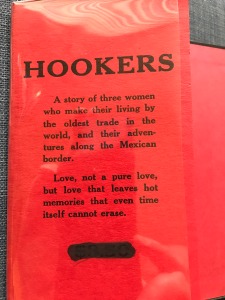- “Hookers” by Richard F. Mann (Rae Bourbon), House of Bourbon, Philadelphia, 1932
Download “Hookers” (PDF file – 16 MB)
Just when you think you’ve come to a dead end researching Ray Bourbon and there’s little new to discover, except confirming or fleshing out one of Ray’s stories, something comes along that opens up a new path to explore.
In 2009, I was doing some searching on Ray using Google Books. The Library of Congress published a regular “Catalog of copyright entries” listing registrations of books and other materials for copyright protection. “Rae Bourbon” popped up in Volume 29, Issue 1 as the copyright registrant for a book – “Hookers” by “Richard F. Mann” – registered on May 14, 1932 and published by the “House of Bourbon” in Philadelphia.
The name “Richard F. Mann” was familiar to me. It’s one of Ray’s aliases listed in his FBI file. In addition, Ray declared bankruptcy in New York in 1945, listing “Richard Fabian Mann” as one of his other names.
I suspected that Ray was actually the author of the book and borrowed a copy via interlibrary loan to make sure.
“Hookers” is a novel that follows the adventures of Pearl as she breaks into the business of being a prostitute in the border town of Juarez. Filled with details about El Paso, the border, bars, nightspots and other locations and flavor of the area, it would be a subject Ray would have been familiar with, since he grew up on the area. We also know that he worked in clubs in Juarez and El Paso at various points in his career.
The writing style of “Hookers” is very similar to Ray’s memoirs – the odd grammar, constant and detailed dialogue, and odd use of capitalization for emphasis are all in evidence in the novel.
There’s no other record of the book and it probably wouldn’t have surfaced except for Ray’s name in the copyright registration. Ray didn’t talk about it to friends later. So, where did it come from? Why did he write it?
In 1932, Ray’s career was in transition. His days in silent movies and vaudeville were behind him and he was just starting to become a fixture in clubs in Los Angeles and San Francisco and had just began his long recording career. He was always looking for ways to promote himself and writing a novel based on the interesting characters he knew would have been another area to explore.
The book was obviously done by a vanity publisher. Ray probably paid to have the books printed himself and it’s likely only a few copies were actually produced. So far, there’s been no review of the book or ads promoting it that have surfaced, so it may have been a project that Ray abandoned or he may have tried selling them at nightclub appearances.
Today, “Hookers” is quite rare. Only three libraries in the country – the University of Delaware, Ohio State and the Library of Congress – hold copies in their collections. A search of used book dealers turned up only two copies for sale.
A copy of the book that I bought from a rare book dealer includes the dust jacket. On the back flap are advertised “Other books by Richard F. Mann” and lists the titles “Blisters (Sequel to Hookers)”, “Meat Market: A Fairy Tale”, “Personal Male”, “Mame’s Place” “and others”. I’ve found none of the other books listed on the jacket.
As a novel, “Hookers” isn’t a lost classic, but it is valuable as a piece of cultural history, giving us some more insight into Ray’s world and preserving period detail about the more seedy world of bars and nightclubs that were never documented in other ways. In the foreword, Ray notes that, “The characters in this story are real, live, and living people, and most of them are still in the fair city of Juarez, plying the oldest trade in the world, and were known personally by the Author, who studied them for several months in pop-eyed amazement.”
The book is dedicated to “Evelyn”, a kind of “wise old sage” prostitute in the book that shows Pearl the ropes. It’s entirely possible that “Evelyn” and “Pearl” were real people that Ray knew in Juarez. The atmosphere and characters are similar to people and events mentioned in the Cuba and Miami sections of Ray’s memiors – they’re archetypes you’d run into in seedy bars still today and no doubt Ray knew them well.
I’ll let you make up your own mind about what it says about Ray, how much of it is true, and how much is Ray’s extravagant imagination.
Since the book was written and copyrighted by Ray, who left no heirs to his estate and there’s no record I can find of any transfer of copyright to other parties, I’m assuming the book is public domain.
Update, 1/19/20: Since finding Hookers, more research on Ray’s pen name, Richard F. Mann, has turned up another book he likely wrote called Speaking of Hams, touted in advertisements in a movie and radio fan magazine in 1930.


